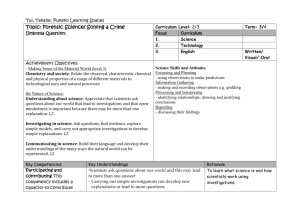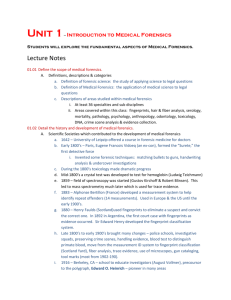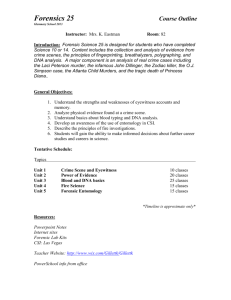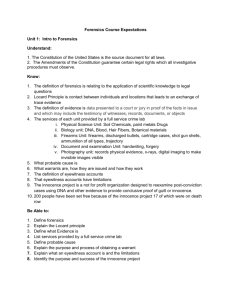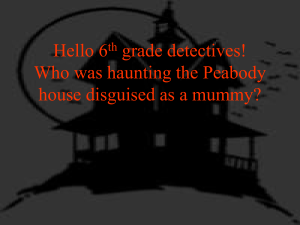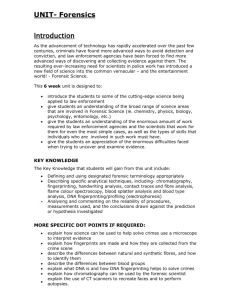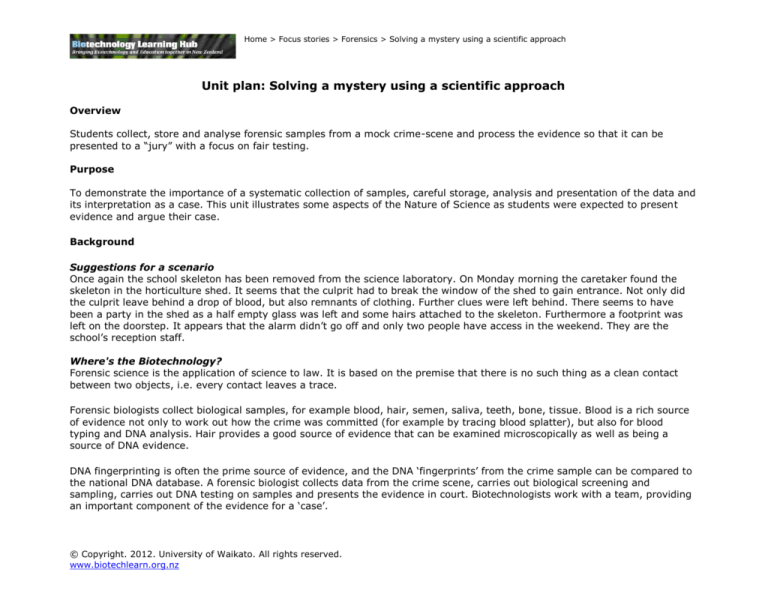
Home > Focus stories > Forensics > Solving a mystery using a scientific approach
Unit plan: Solving a mystery using a scientific approach
Overview
Students collect, store and analyse forensic samples from a mock crime-scene and process the evidence so that it can be
presented to a “jury” with a focus on fair testing.
Purpose
To demonstrate the importance of a systematic collection of samples, careful storage, analysis and presentation of the data and
its interpretation as a case. This unit illustrates some aspects of the Nature of Science as students were expected to present
evidence and argue their case.
Background
Suggestions for a scenario
Once again the school skeleton has been removed from the science laboratory. On Monday morning the caretaker found the
skeleton in the horticulture shed. It seems that the culprit had to break the window of the shed to gain entrance. Not only did
the culprit leave behind a drop of blood, but also remnants of clothing. Further clues were left behind. There seems to have
been a party in the shed as a half empty glass was left and some hairs attached to the skeleton. Furthermore a footprint was
left on the doorstep. It appears that the alarm didn’t go off and only two people have access in the weekend. They are the
school’s reception staff.
Where's the Biotechnology?
Forensic science is the application of science to law. It is based on the premise that there is no such thing as a clean contact
between two objects, i.e. every contact leaves a trace.
Forensic biologists collect biological samples, for example blood, hair, semen, saliva, teeth, bone, tissue. Blood is a rich source
of evidence not only to work out how the crime was committed (for example by tracing blood splatter), but also for blood
typing and DNA analysis. Hair provides a good source of evidence that can be examined microscopically as well as being a
source of DNA evidence.
DNA fingerprinting is often the prime source of evidence, and the DNA ‘fingerprints’ from the crime sample can be compared to
the national DNA database. A forensic biologist collects data from the crime scene, carries out biological screening and
sampling, carries out DNA testing on samples and presents the evidence in court. Biotechnologists work with a team, providing
an important component of the evidence for a ‘case’.
© Copyright. 2012. University of Waikato. All rights reserved.
www.biotechlearn.org.nz
Home > Focus stories > Forensics > Solving a mystery using a scientific approach
Curriculum focus
Science curriculum
Interpretation of biological evidence is based on the inherent variability of characteristics found within species. This variability is
particularly evident in DNA analysis.
The development and presentation of a prosecution ‘case’ provides an illustration of the scientific process and is the basis for an
increased understanding of the Nature of Science.
Focus of strategy & skill development
This unit has an applied science focus with an emphasis on the systematic collection, collation and storage of biological
evidence, and its interpretation and presentation as part of a case. It illustrates the scientific process.
Teaching resources
Health and Safety
It is important that no human tissue is used. Artificial blood can be provided for blood typing and food colouring or cordial can
be used to set up the blood splattering scenarios.
© Copyright. 2012. University of Waikato. All rights reserved.
www.biotechlearn.org.nz
Home > Focus stories > Forensics > Solving a mystery using a scientific approach
UNIT PLAN: SOLVING A MYSTERY USING A SCIENTIFIC APPROACH
Suggested learning intentions
Suggested learning experiences
Possible teaching/assessment
activities
The following learning experiences will
provide you with starting points for an
exploration of this topic. You may
decide to narrow your focus to one
component, or include most of the ideas
in a unit that incorporates science and/or
technology themes.
Forensic evidence must be collected in a
systematic way that allows for a wide
range of data gathering opportunities
and analysis.
Session 1 – Introduction
Introduction of the unit and identification
of the endpoint (analysis and
presentation of evidence) as a
consequence of working through a
‘detective game’. Problem presentation
(see scenario). Photographs produced
for class to analyse the evidence that will
need to be investigated.
Scenario scene: Horticulture shed
containing skeleton, broken glass,
clothing remnant attached to the
glass, glass partially filled with wine
and with fingerprints, hairs on the
skeleton. Two suspects who are
primed with a story.
Organisation: The class is
organised into groups of 6. Each
member of the group is responsible
for becoming the expert in the
© Copyright. 2012. University of Waikato. All rights reserved.
www.biotechlearn.org.nz
Develop a plan that contains methods
and predicted outcomes that is related to
the scenario description,
[Criteria: identification of science
concept, method and predicted outcome
for each technique; strategy for
recording data (evidence), proposal of
how evidence will be analysed.]
Group conferencing with teams and
teacher to explain the system to be used
for collecting data. Justification for
including different collection strategies
within the plan (formative assessment
within the group).
Home > Focus stories > Forensics > Solving a mystery using a scientific approach
collecting and analysing of a
particular component of the
evidence (‘Home and Away’, where
students develop their expertise and
then share this information with the
rest of their group).
Note: some of the activities may take
longer. Divide up the tasks accordingly
(six tasks for expertise development
amongst the group).
Specialist areas of information
required:
Taking statements - reliability
of observation.
Composition of blood and
blood typing.
Variability of fingerprints and
techniques for collection and
presentation.
Microscopic examination of
hair and fibres (microscope
use and recording
observations).
Chemical analysis of glass
contents - pH, density and
appearance.
Session 2 – Planning and
developing specialist expertise.
Developing expertise within
the expert groups (Develop
understanding and
techniques for gathering,
analysing and interpreting
data).
© Copyright. 2012. University of Waikato. All rights reserved.
www.biotechlearn.org.nz
Home > Focus stories > Forensics > Solving a mystery using a scientific approach
The construction of a case requires
planning that can be justified in a court
of law.
Fair testing underpins the process by
which samples from the crime scene can
be compared with suspect samples.
Sample comparison is based on the
scientific understanding of variability of
biological characteristics.
Interview with experts
(police/lawyer/forensic
scientist).
Meeting with original group
to plan the collection of
evidence from the ‘scene of
the crime’.
Sessions 3 and 4 – Collection of
Evidence
Teacher-led discussion of the
importance of carrying out a fair
test and collecting and recording
evidence systematically.
Planned collection of evidence.
Using the expertise from ‘expert
groups’ to test and record results.
Development of a group record.
The elaboration of an evidence collecting
plan with sequence identified and
justification via annotation (formatively
monitored by teacher).
Session 5 and 6 – Analysis of
evidence
Expert groups develop expertise.
Develop standards and test samples
from suspects. Prepare the samples
beforehand so that they can produce the
evidence (e.g. blood smear on a slide)
on demand.
Systematic record of evidence that has
been developed for the group.
Criteria: scientific method evident,
sequence identified, observations and
data recorded, analysis explained, group
participation apparent.
Session 7 and 8 – Presentation
development
Group planning for presentation
of evidence. Classification of
evidence into primary and
secondary sources.
Workshop to present evidence
according to the criteria identified
© Copyright. 2012. University of Waikato. All rights reserved.
www.biotechlearn.org.nz
Home > Focus stories > Forensics > Solving a mystery using a scientific approach
for group assessment
Collection of evidence from a crime
scene must be underpinned by an
understanding of the scientific method
(systematic collection, analysis,
interpretation and justification of
interpretation) and the need for
triangulation.
Session 9 – Presentation of evidence
to a ‘jury’ (summative assessment).
PowerPoint presentation, charts and/or
the enactment of the presentation in a
‘court’.
Summative assessment
Evidence is collected and presented in a
form that demonstrates an
understanding of scientific method. The
presentation of a scientific argument
that demonstrates the need for
triangulation.
Criteria include an awareness of:
scientific data gathering
justification of sequence and
methodology
development of an hypothesis
and the presentation of a range
of evidence as proof.
© Copyright. 2012. University of Waikato. All rights reserved.
www.biotechlearn.org.nz


